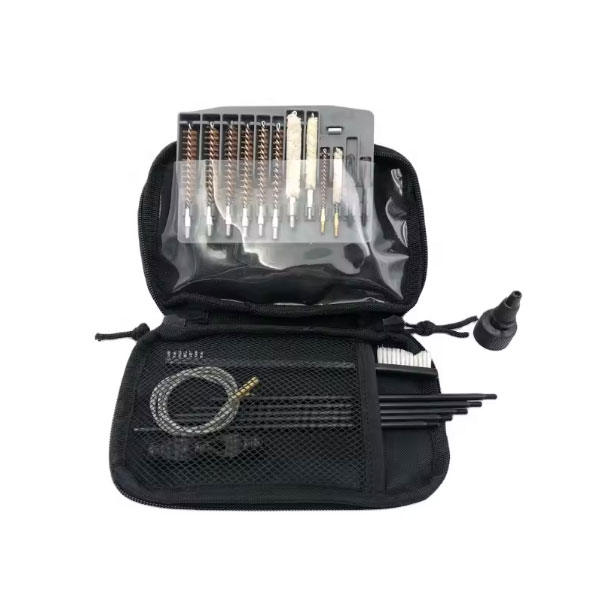
- English
- Español
- Português
- русский
- Français
- 日本語
- Deutsch
- tiếng Việt
- Italiano
- Nederlands
- ภาษาไทย
- Polski
- 한국어
- Svenska
- magyar
- Malay
- বাংলা ভাষার
- Dansk
- Suomi
- हिन्दी
- Pilipino
- Türkçe
- Gaeilge
- العربية
- Indonesia
- Norsk
- تمل
- český
- ελληνικά
- український
- Javanese
- فارسی
- தமிழ்
- తెలుగు
- नेपाली
- Burmese
- български
- ລາວ
- Latine
- Қазақша
- Euskal
- Azərbaycan
- Slovenský jazyk
- Македонски
- Lietuvos
- Eesti Keel
- Română
- Slovenski
- मराठी
- Srpski језик
What Are the Tips for Choosing a Rifle Cleaning Kit?
2025-04-10
A well-maintained gun is a good gun. If the gun jams at an important moment, it will put the gun owner in a very dangerous situation, so it is important to keep our weapons clean at all times. Then the necessity of having a Rifle Cleaning Kit is experienced.
Cleaning rods are a key component of the Rifle Cleaning Kit. They are used to push cleaning cloths, cleaning claws, cleaning brushes, and other tools into the barrel for cleaning. So what are the categories of cleaning rods?

One-piece cleaning rods are known for their durability because they are made of a whole piece of material. This makes them less likely to bend or break under pressure. Professionals and gun enthusiasts usually prefer this type. Cleaning rods can be made of a variety of materials, each of which has its own unique advantages and disadvantages.
Steel: Although steel rods are extremely resilient and durable, they can damage the inside of the barrel if not handled properly.
Brass: Brass gun rods are softer than steel rods and are less likely to scratch the barrel. The disadvantage is that they are more likely to bend under pressure.
Carbon Fiber: Carbon fiber gun rods are a perfect blend of the strengths of steel and brass rods. They are highly strong and flexible, but won't scratch the barrel.
Coated Steel: Some steel rods come with a soft coating, such as nylon or vinyl, that combines the sturdiness of steel with the flexibility of softer materials.
Gun cleaning rods are caliber-specific, which means you'll need multiple cleaning rods if you have more than one gun in your collection.
Bore brushes are used to clean the inside of a gun barrel. They help to remove and dislodge stubborn dirt that builds up after shooting, including gunpowder residue, lead, copper, and other residue.
Bore brushes can be divided into the following categories based on the material they are made of:
Bronze/Brass Brushes: This is the most common type of bore brush. Brass or bronze bristles are strong enough to scrub away stubborn dirt, but soft enough not to damage the rifling of the barrel.
Nylon Brushes: Nylon brushes are softer than metal brushes and are less likely to wear down the barrel over time. They are especially useful for guns with weaker or older barrels, or for lighter cleaning tasks.
Cleaning claws are also an indispensable gadget in the Rifle Cleaning Kit. They are small attachments that attach to the cleaning rod and are used to hold the cleaning patch in place while pushing it into the barrel. There are two main types: slotted and fitted.
Slotted cleaning claws: These cleaning claws have a slot or ring on them for inserting the cleaning patch. The patch is then folded and pushed into the barrel. This design is very simple, so slotted cleaning claws are popular with many gun owners.
Fitted cleaning claws: These cleaning claws are designed to hold the patch tightly to the barrel for more thorough cleaning. They are usually spiked or button-shaped, and the cleaning patch is wrapped around it. The patch enters the barrel before the cleaning claws, forming a tight fit that allows the patch to make full contact with the barrel wall.
Regardless of the type, cleaning claws are designed for specific calibers, which means they are designed to fit a specific chamber size. Using the right size cleaning claw is essential for a comprehensive and safe cleaning process. Toothed teeth that are too small may not adequately engage with the barrel, while teeth that are too large may get stuck.
Having a suitable Rifle Cleaning Kit is the icing on the cake for gun enthusiasts. I hope you choose the right gun cleaning tool!




